
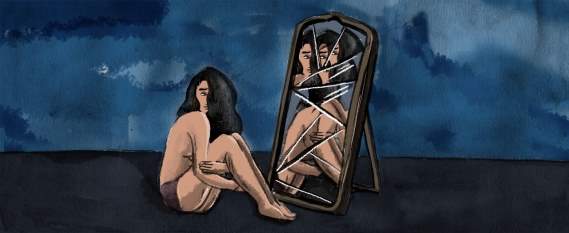
(Dubick, 2017).
BODY
DYSMORPHIC
DISORDER

(Dubick, 2017).
Contents
Body Dysmorphic Disorder (BDD) Page 2
What is Body Dysmorphic Disorder (BDD) Page 3
What impact does BDD have on an individual’s life? Page 5
BDD Signs and Symptoms Page 6
Negative Attitudes and Stigma towards BDD Page 7
BDD Treatment Page 8
Who is most likely to be affected by BDD? Page 9
Does BDD affect men and women differently? Page 10
Causes of BDD Page 11
Can other disorders be associated with BDD? Page 12
- Obsessive-Compulsive Disorder (OCD) Page 12
- Depression Page 13
Support Agencies Page 14
Body Dysmorphic Disorder (BDD)
This booklet includes information, symptoms, possible causes, treatment advice and more on BDD. It is designed to help people suffering from the disorder as well as information for family and friends.
What is Body Dysmorphic Disorder (BDD)
BDD (also known as dysmorphophobia) is an anxiety disorder related to obsessive-compulsive disorder (OCD). It is based on a person’s judgment regarding their physical appearance, often noticing very minor or non-existent defects. Individuals suffering with BDD obsessively focus on and worry about these certain self-imperfections and flaws (Mind, 2013a).
Many people dislike something about their body or appearance, for most, this will not cause issues or interfere with daily life, however, for BDD sufferers, this can be quite the opposite. These perceived imperfections can cause persistent negative thoughts and unhealthy obsessions which often lead to extreme anxiety and emotional distress (ADAA, 2018a).
People suffering with BDD often find themselves developing repetitive, obsessive, uncontrollable behaviours and urges around the focused feature to try and disguise them (in a similar way to OCD).
The severity of BDD differs between individuals. In more severe cases, the individual may attempt to completely isolate themselves away from people to avoid any potential public humiliation (Mind, 2013c).
It is not uncommon for individuals suffering with BDD to request help from cosmetic surgeons and dermatologists (in attempt to hide their perceived flaws) rather than seeking help from a mental health professional.
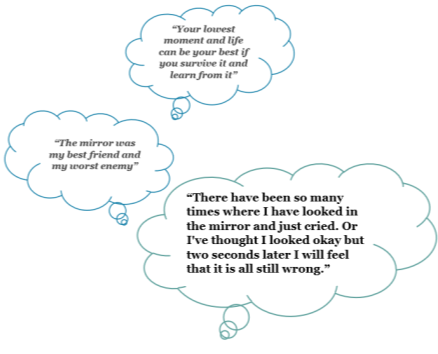 The prognosis for someone with BDD is very assuring when provided with the correct care and treatment. Support from family and friends also play a vital role in helping an individual towards recovery (Cleveland Clinic, 2018).
The prognosis for someone with BDD is very assuring when provided with the correct care and treatment. Support from family and friends also play a vital role in helping an individual towards recovery (Cleveland Clinic, 2018).
(Goodreads, 2019).
What impact does BDD have on an individual’s life?
BDD may have a significant impact on a person’s daily life. In severe cases, it may limit and negatively affect family life, social activities and employment due to the feeling of embarrassment and shame. It may also result in isolation or becoming housebound (BDD Foundation, 2016b). However, a diagnosis is not necessarily bad. It can also provide a sense of relief and hope that support and recovery is underway. Mixed emotions are expected following a diagnosis and many will worry about the impacts of disclosure due to discrimination and stigma (HeretoHelp, 2011).
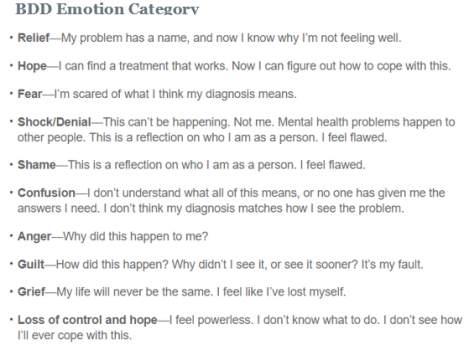
(HeretoHelp, 2011).
BDD Signs and Symptoms
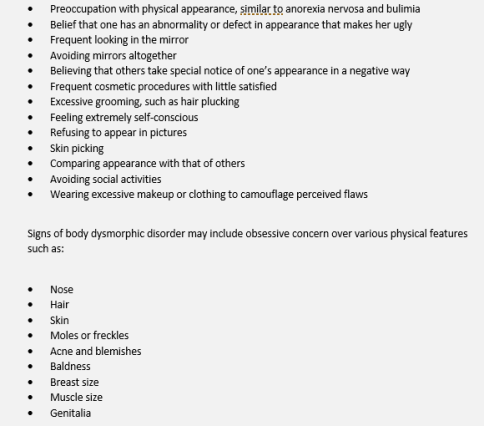
(Timberline Knolls, 2018).
Negative attitudes and stigma towards BDD
Stigma and negative attitudes such as being ‘vain’, ‘self-obsessed’ or ‘a narcissistic’ are unfortunately common towards BDD. Such attitudes may correlate between mental illness ignorance and the obsessively repetitive symptoms, including: looking in mirrors, grooming, cosmetic coverage and workouts (Freeston and Kendall, 2006). This can become internalised and dramatically impact a person’s self-esteem, life and confidence, preventing them from getting help, partaking in events and social opportunities. Depression and anxiety can also follow on from this stigma leading to additional symptoms followed by further stigma (Dinos et al., 2004).
“I think there is a huge amount of stigma around BDD, it is normally associated with vanity. For males, they feel like they will be seen as gay or weird for caring about the way they look and seen as not masculine.’
(Sherriff, 2015).
BDD Treatment
Mild-moderate symptoms
- Cognitive behavioural therapy (CBT); assisting to change negative thoughts and attitudes (between 5-20 sessions may be required dependant on severity).
- Antidepressants, called ‘selective serotonin reuptake inhibitors’ (SSRI) (usually ‘Fluoxetine’ initially); to increase serotonin levels in the brain (usually taken for several months).
More severe symptoms or if the above do not work separately
- Both of the above treatments together.
(Phillips, Albertini and Rasmussen, 2002).
Who is most likely to be affected by BDD?
BDD can affect a person of any age, gender, race or ethnicity. It is believed that the disorder is more prevalent than evidenced as many people hide their symptoms and avoid seeking medical advice due to embarrassment (Phillips, 2018).
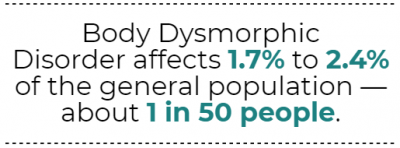
(ADAA, 2018a).
Studies indicate, from those affected, around 40% are men and 60% are women. Approximately two thirds of sufferers will start to experience symptoms of the disorder during late adolescents (before age 18), for many, it can take around 15 years to seek professional help (BDD Foundation, 2016a). Studies also report that amongst these statistics, the attempted suicide rate is extortionate at 25% (Granet, 2018).
Does BDD affect men and women differently?
BDD tends to affect men and women in similar ways. Women may be more concerned by the ‘ideal’ body, including, breast size and symmetry, weight, hip width and legs, whereas men may focus more on aspects such as hair thinning, genitals or their body physique (BDD Foundation, 2016a).
Muscle dysmorphia disorder (MDD) is a form of BDD.
The main concern of MDD is muscle size or physique. People with MDD often perceive themselves as being too small, when they are of ideal proportion or even more muscular than the average person (Phillips, 2004).
Some people will turn to extreme workout routines, anabolic steroids and supplements as well as a strict high protein diet to build muscle; this can lead to several health problems (Leone, Sedory and Gray, 2005).
Causes of BDD
The exact cause of BDD is unknown, however, several factors are likely involved in its pathogenesis: bullying, low self-esteem, autophobia, biological (genetics and neurotransmitters), other disorders including: depression, anxiety and obsessive-compulsive disorder (OCD) (Mind, 2013a).
Can other disorders be associated with BDD
BDD sufferers may be more prone to anxiety, depression, eating disorders and obsessive-compulsive disorder (OCD). Each have comparable symptoms, sometimes leading to misdiagnosis (ADAA, 2018b).
OCD
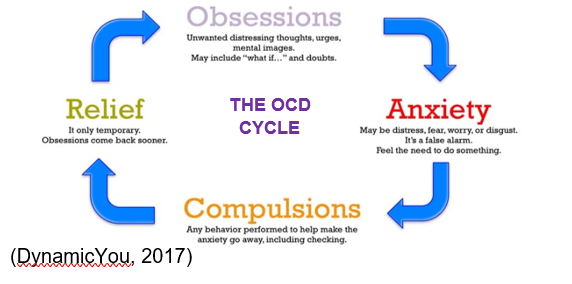 A type of anxiety disorder affecting approximately 12 in 1000 people. Predominant in adolescents, although all ages may be affected. Around 50% of diagnosed cases are classified as severe (OCDUK, 2018). OCD includes multiple uncontrollable reoccurring thoughts and behaviours. Individuals often act on their compulsion to eliminate upsetting or unpleasant thoughts and feelings. OCD can consume a large portion of a person’s daily life and interfere with vital and social activities (International OCD Foundation, 2018).
A type of anxiety disorder affecting approximately 12 in 1000 people. Predominant in adolescents, although all ages may be affected. Around 50% of diagnosed cases are classified as severe (OCDUK, 2018). OCD includes multiple uncontrollable reoccurring thoughts and behaviours. Individuals often act on their compulsion to eliminate upsetting or unpleasant thoughts and feelings. OCD can consume a large portion of a person’s daily life and interfere with vital and social activities (International OCD Foundation, 2018).
Depression
A condition affecting approximately 1 in 4 people. Symptoms include a persistent feeling of extreme sadness, anxiety and hopelessness. Women tend to be twice as susceptible to depression as men, it can affect any age group. Depression does not have a singular cause, it solely depends on the individual. However, some common causes include:
- Loss of a job or home.
- Financial crises.
- Bereavement.
- Divorce.
- Other traumatic experiences.
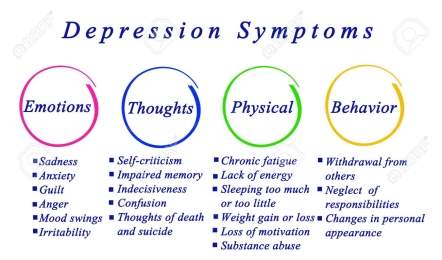 (Albert, 2015).
(Albert, 2015).
(Marigranula, 2018)
Support Agencies
Mind
Mind offers fundamental support, and advice with easily accessible, helpful resources and materials for those in need, including information on: different disorders, medication, treatment, self-help (improving well-being), coping strategies and alternate helplines. Also providing direct links and contacts to free online programmes, support groups, peer support and emergencies. However, to pursue recovery, actual treatment is required along with professional help which the agency cannot offer. Further to this, the opening hours are 9am-5pm weekdays; a person’s mental health is not determined by time (Mind, 2013d).
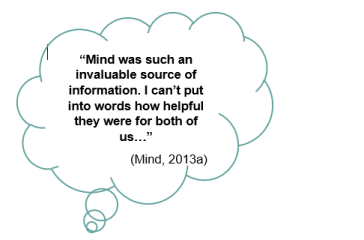
Rethink
Offers a range of advice, support and free factsheets on mental illness including: medication, information, services, welfare benefits, care and more, all extremely beneficial for those in need. Rethink does not offer crisis support (immediate) and although webchat is available, it is very limited (Rethink, n.d).
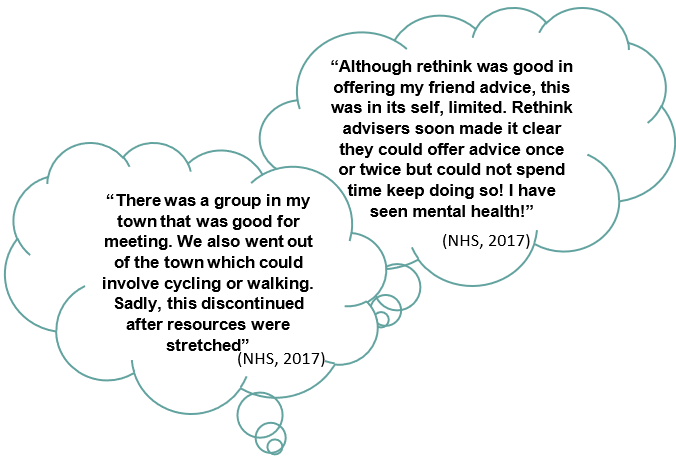 Rethink also organises group activities to build self-esteem, however, lacks resources for larger towns resulting in cancellations where groups are oversized (NHS, 2017).
Rethink also organises group activities to build self-esteem, however, lacks resources for larger towns resulting in cancellations where groups are oversized (NHS, 2017).
Word Count 1100
References:
- Albert, P. R. (2015) ‘Why is depression more prevalent in women?’, Journal of Psychiatry and Neuroscience. doi: 10.1503/jpn.150205.
- Anxiety and Depression Association of America (2018a). Body Dysmorphic Disorder (BDD). Available at: https://adaa.org/understanding-anxiety/related-illnesses/other-related-conditions/body-dysmorphic-disorder-bdd [online] (Accessed 24th December 2018).
- Anxiety and Depression Association of America (2018b). Body Dysmorphic Disorder (BDD). Available at: https://adaa.org/understanding-anxiety/related-illnesses/other-related-conditions/body-dysmorphic-disorder-bdd#BDD%20and%20Other%20Mental%20Health%20Disorders [online] (Accessed 27th December 2018).
- Body Dysmorphic Disorder Foundation (2016a). About BDD. Available at: https://bddfoundation.org/helping-you/about-bdd/#about-bdd [online] (Accessed 26th December 2018).
- Body Dysmorphic Disorder Foundation (2016b). What are the effects of BDD on life? Available at: https://bddfoundation.org/helping-you/about-bdd/#what-are-the-effects-of-bdd-on-life [online] (Accessed 1st January 2019).
- Cleveland Clinic (2018). Body Dysmorphic Disorder: Outlook/Prognosis. Available at: https://my.clevelandclinic.org/health/diseases/9888-body-dysmorphic-disorder/outlook–prognosis [online] (Accessed 31st December 2018).
- Dinos, S. et al. (2004) ‘Stigma: The feelings and experiences of 46 people with mental illness – Qualitative study’, British Journal of Psychiatry. doi: 10.1192/bjp.184.2.176.
- Dubick, S (2017). ‘In the Mirror, What I Saw Was a Monster’: Living with Body Dysmorphic Disorder. Available at: https://broadly.vice.com/en_us/article/ywmg5m/in-the-mirror-what-i-saw-was-a-monster-living-with-body-dysmorphic-disorder [online image] (Accessed 30th December 2018).
- Dynamic You (2017). Obsessive Compulsive Disorder | The OCD Cycle of Despair. Available at: https://dynamicyou.org/obsessive-compulsive-disorder-ocd-cycle-despair/ [online image] (Accessed 27th December 2018).
- Freeston, M. H. and Kendall, T. (2006) ‘Obsessive-compulsive disorder: Core interventions in the treatment of obsessive-compulsive disorder and body dysmorphic disorder’, The British Psychological Society and The Royal College of Psychiatrists. doi: 10.1037/0021-843X.114.2.197.
- Goodreads, (2019), Body dysmorphic disorder quotes. Available at: https://www.goodreads.com/quotes/tag/body-dysmorphic-disorder [online quotes] (Accessed 1st January 2019).
- Here to Help (2011). Dealing with a mental illness diagnosis. Available at: http://www.heretohelp.bc.ca/sites/default/files/dealing-with-a-mental-illness-diagnosis.pdf (Accessed 1st January 2019).
- International OCD Foundation (2018). What is OCD? Available at: https://iocdf.org/about-ocd/ [online] (Accessed 27th December 2018).
- Leone, J. E., Sedory, E. J. and Gray, K. A. (2005) ‘Recognition and treatment of muscle dysmorphia and related body image disorders’, Journal of Athletic Training.
- Marigranula (2018). Depression symptoms. Available at: https://www.123rf.com/photo_46915026_depression-symptoms.html [online image] (Accessed 31st December 2018).
- Mind (2013a). Body dysmorphic disorder (BDD). Available at: https://www.mind.org.uk/information-support/types-of-mental-health-problems/body-dysmorphic-disorder-bdd/#.XCELPFz7RPY [online} (Accessed 24th December 2018).
- Mind (2013b). Obsessive-compulsive disorder (OCD). Available at: https://www.mind.org.uk/information-support/types-of-mental-health-problems/obsessive-compulsive-disorder-ocd/ocd-causes/#beliefs [online] (Accessed 27th December 2018).
- Mind (2013c). What is body dysmorphic disorder (BDD)? Available at: https://www.mind.org.uk/information-support/types-of-mental-health-problems/body-dysmorphic-disorder-bdd/#.XCpJblz7RPZ [online] (Accessed 31st December 2018).
- Mind (2013d). Information & Support. Available at: https://www.mind.org.uk/information-support/ [online] (Accessed 3rd January 2019).
- NHS (2017). Rethink Mental Illness. Available at: https://www.nhs.uk/Services/Trusts/ReviewsAndRatings/DefaultView.aspx?id=91024 [online] (Accessed 3rd January 2019).
- Obsessive-Compulsive Disorder UK (2018). Occurrences of OCD. Available at: https://www.ocduk.org/ocd/how-common-is-ocd/ [online] (Accessed 27th December 2018).
- Phillips, K. A., Albertini, R. S. and Rasmussen, S. A. (2002) ‘A randomized placebo-controlled trial of fluoxetine in body dysmorphic disorder’, Archives of General Psychiatry. doi: 10.1001/archpsyc.59.4.381.
- Phillips, K. (2004) ‘Body dysmorphic disorder: recognizing and treating imagined ugliness.’, World psychiatry : official journal of the World Psychiatric Association (WPA). doi: 10.1007/s00270-008-9301-0.
- Phillips, K (2018). Prevalence of BDD. Available at: https://bdd.iocdf.org/professionals/prevalence/ [online] (Accessed 26th December 2018).
- Rethink Mental Illness (n.d). Our goal is a better life for everyone affected by mental illness. Available at: https://www.rethink.org/about-us/our-mental-health-advice [online] (Accessed 3rd January 2019).
- Sherriff, L (2015). What Is Body Dysmorphic Disorder? And What’s It Like If You Have It? Available at: https://www.huffingtonpost.co.uk/2015/05/12/whats-body-dysmorphic-disorder-whats-it-like-having-it_n_7265452.html [online quote] (Accessed 1st January 2019).
- Timberline Knolls (2018). Body Dysmorphic Disorder Symptoms and Side-Effects. Available at: https://www.timberlineknolls.com/eating-disorder/body-dysmorphia/signs-effects/ [online] (Accessed 31st December 2018).
Cite This Work
To export a reference to this article please select a referencing style below:

